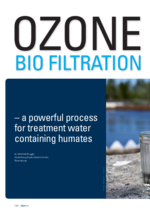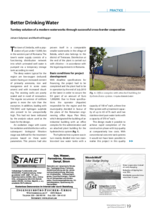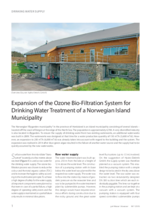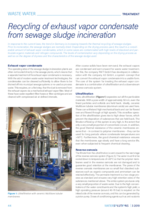
gwf international - 2010/09
The town of Jimbolia, with a populationof just under 13,000, lies in the westernpart of Romania, approximately 600 kilo-meters from the capital of Bucharest, onthe border with Serbia. The town's watersupply consists of a functioning distribu-tion network into which untreated wellwater from eight different deep wellswas pumped via a temporary storagetank according to need. A water treat-ment plant built a little over 30 years agowith cascade ventilation was already shut down again just a few months after com-missioning, as the plant did not operateproperly and the building was leaky andcompletely unusable. ...

water solutions 2017/03
Ozone bio-filtration is an established process for treating sur-face water to obtain potable water. As a practical example, this report describes a new way of designing treatment plants using stainless steel filters manufactured at the site. In 2013–2014 an entirely new water treatment plant was erected in Norway to reduce the colour and TOC and to increase the hygienic safety of surface water obtained from a local lake. This plant has a maximum treatment capacity of 680 m³/h, and its operation is based on the ozone bio-filtration process. The new plant has been in continuous operation since the end of August 2014 and supplies potable water in good quality to the network. ...

water solutions 2020|2
A completely new treatment system for deacidification and manganese removal has been built to supply water to the Norwegian town of Hønefoss (Ringerike kommune). With a capacity of 230 l/s, the plant has been equipped with the latest technology from the Ravensburg-based HydroGroup®. The German company and its Bergen-based Norwegian subsidiary Hydro-Elektrik AS managed to impress with their proposed solution and beat off the Norwegian competition during the bidding process.

bluefacts - 05/2012
Ozone bio filtration is an established method for treatment water containing humates and other undesirable substances. Under the influence of ozone as a strong oxidation agent, the organic carboncompounds are split and the concentrations of assimilable organic materials increase. In addition tothe fundamental basics, the results from different operational plants will also be outlined in this article. ...

gwf international - 2010/09
The town of Jimbolia, with a populationof just under 13,000, lies in the westernpart of Romania, approximately 600 kilo-meters from the capital of Bucharest, onthe border with Serbia. The town's watersupply consists of a functioning distribu-tion network into which untreated wellwater from eight different deep wellswas pumped via a temporary storagetank according to need. A water treat-ment plant built a little over 30 years agowith cascade ventilation was already shut down again just a few months after com-missioning, as the plant did not operateproperly and the building was leaky andcompletely unusable. ...

gwf-Wasser/Abwasser - 09/2013
The Norwegian municipality of Bamble with headquarters in Langesund (Telemark) uses surface water from the inland lake "Flåte" to supply drinking water to approximately 12,000 people (water level approx. 53 m above sea level). The water is drawn by a pumping station and supply line erected on the lake itself for extraction of subterranean water. The water treatment currently in use, comprises a coarse preliminary purification by means of a plane sieve with subsequent chlorination and water glass dosing to raise the pH-value. After the water treatment the water is pumped into the elevated tank located about 85 m higher.

The Norwegian “Øygarden municipality” in the province of Hordaland is an island municipality consisting of several islands – located off the coast of Bergen at the edge of the North Sea. The waterworks was designed at 2009 for a water production quantity of 150 m³/h (3,600 m³/d). How-ever, an expansion to 250 m³/h (6,000 m³/d) was already taken into account with regard to the building and the system. The expansion was realised in 2014.

water solutions 2017/03Ozone bio-filtration is an established process for treating sur-face water to obtain potable water. As a practical example, this report describes a new way of designing treatment plants using stainless steel filters manufactured at the site. In 2013–2014 an entirely new water treatment plant was erected in Norway to reduce the colour and TOC and to increase the hygienic safety of surface water obtained from a local lake. This plant has a maximum treatment capacity of 680 m³/h, and its operation is based on the ozone bio-filtration process. The new plant has been in continuous operation since the end of August 2014 and supplies potable water in good quality to the network. ...

gwf-Wasser/Abwasser International - 2012
As part of the cross-border EU-subsidised project “Safeguarding the water supply in the German-Luxembourg border area”, the three neighbouring water supply associations along the River Mosel (SIDERE (Luxembourg), Verbandsgemeindewerke Konz (VGW Konz, Germany) and water supply Saar-Obermosel (WSO, Germany)) have agreed a joint action plan in order to guarantee the supply of water in the future. To this end, the hydraulic capacity of the existing central drinking water treatment plant Wasserliesch (VGW Konz) had to be extended, and the approximately 30 year-old plant had to be fully renovated to reflect the current state of the art.

WATER SOLUTIONS 3/2019
In response to the current laws, the trend in Germany is increasing towards the thermal recycling of sewage sludges. Prior to incineration, the sewage sludges are normally dried. Depending on the drying process used, the result is a considerable amount of exhaust vapor condensates, which in some cases are contaminated with high levels of dissolved and particulate organic materials and nitrogen compounds. The levels of contamination vary depending on the drying process as well as on the degree of dryness and the characteristics of the sewage sludge used.
